|

by Jonathan Benson
staff writer
November 24, 2011
from
NaturalNews Website
German version
Literal beacons of the "green" energy movement, giant wind turbines
have been one of the renewable energy sources of choice for the US
government, which has spent billions of taxpayer dollars subsidizing
their construction and use across the country.
But high maintenance costs, high rates
of failure, and fluctuating weather conditions that affect energy
production render wind turbines expensive and inefficient, which is
why more than 14,000 of them have since been abandoned.
Before government subsidies for the giant metals were cut or
eliminated in many areas, wind farms were an energy boom business.
But in the post-tax subsidy era, the
costs of maintaining and operating wind turbines far outweighs the
minimal power they generate in many areas, which has left a
patchwork of wind turbine graveyards in many of the most popular
wind farming areas of the US.
"Thousands of abandoned wind
turbines littered the landscape of wind energy's California 'big
three' locations which include Altamont Pass, Tehachapin and San
Gorgonio, considered among the world's best wind sites," writes
Andrew Walden of the American Thinker.
"In the best wind spots on earth,
over 14,000 turbines were simply abandoned. Spinning,
post-industrial junk which generates nothing but bird kills."
Walden speaks, of course, about the
birds, bats, and other air creatures that routinely get tangled in
and killed by wind turbine propellers.
And as far as the "post-industrial junk"
language, well, if it costs too much to run the machines in the
first place, then it definitely costs too much to uproot and remove
them post-construction.
This whole wind energy mess just further illustrates how the
American people have been played by their elected officials who
bought into
the "global warming" hysteria that spawned the push for
wind energy in the first place.
And now that the renewable energy tax
subsidies are gradually coming to an end in some places, the true
financial and economic viability, or lack of wind energy, is on
display for the world to see.
"It is all about the tax subsidies,"
writes Don Surber of the Charleston Daily Mail.
"The blades churn until the money
runs out. If an honest history is written about the turn of the
21st century, it will include a large, harsh chapter
on how fears about global warming were overplayed for profit by
corporations."
14,000 Abandoned Wind Turbines
...in The USA
by
Tory Aardvark
November 17, 2011
from
ToryAardvark Website
German version
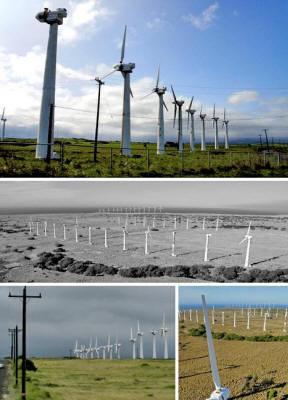
Abandoned wind farm at South Point Hawaii
There are many
hidden truths about the world of
wind turbines from the pollution and environmental damage caused in
China by manufacturing bird choppers, the blight on people’s lives
of noise and the flicker factor and the
countless numbers of birds that are killed
each year by these blots on the landscape.
The symbol of Green renewable energy, our savior from
the non existent problem of Global
Warming, abandoned wind farms are starting to litter the
planet as globally governments cut the subsidies taxes that
consumers pay for the privilege of having a very expensive power
source that does not work every day for various reasons like it’s
too cold or the wind speed is too high.
The US experience with wind farms has left over 14,000 wind turbines
abandoned and slowly decaying, in most instances the turbines are
just left as symbols of a dying Climate Religion, nowhere
have the Green Environmentalists appeared to clear up their
mess or even complain about the abandoned wind farms.
The US has had wind farms since 1981:
“Some say that Ka Le is haunted -
and it is. But it’s haunted not by Hawaii’s legendary night
marchers. The mysterious sounds are “Na leo o Kamaoa” - the
disembodied voices of 37 skeletal wind turbines abandoned to
rust on the hundred-acre site of the former Kamaoa Wind Farm…
The ghosts of Kamaoa are not alone in warning us. Five other
abandoned wind sites dot the Hawaiian Isles - but it is in
California where the impact of past mandates and subsidies is
felt most strongly. Thousands of abandoned wind turbines
littered the landscape of wind energy’s California “big three”
locations - Altamont Pass, Tehachapin (above), and San Gorgonio
- considered among the world’s best wind sites…
California’s wind farms - comprising about 80% of the
world’s wind generation capacity - ceased to generate much more
quickly than Kamaoa. In the best wind spots on earth, over
14,000 turbines were simply abandoned.
Spinning, post-industrial junk which
generates nothing but bird kills…”
The problem with wind farms when they
are abandoned is getting the turbines removed, as usual there are
non Green environmentalists to be seen:
The City of Palm Springs was forced
to enact an ordinance requiring their removal from San Gorgonio.
But California’s Kern County, encompassing the Tehachapi area,
has no such law.
Imagine the outraged Green chorus if
those turbines were abandoned oil drilling rigs.
It took nearly a decade from the
time the first flimsy wind turbines were installed before the
performance of California wind projects could dispel the
widespread belief among the public and investors that wind
energy was just a tax scam.
Ben Lieberman, a senior policy analyst focusing on energy
and environmental issues for the Heritage Foundation, is not
surprised.
He asks:
“If wind power made sense, why
would it need a government subsidy in the first place? It’s
a bubble which bursts as soon as the government subsidies
end.”
“It’s a bubble which bursts as soon as
the government subsidies end” therein lies a lesson that is going be
learnt by those that sought to make fortunes out of tax payer
subsidies.
The whole renewables industry of solar,
wind and biomass is just an artificial bubble
incapable of surviving without subsides from governments and tax
payers which many businesses and NGO’s like WWF, FoE and Greenpeace
now think is
their god given right, as the money
is going on Green Climate Religion approved clean energy.
The Green evangelists who push so hard for these wind farms, as
usual have not thought the whole idea through, no surprises for a
left agenda like
Climate Change, which like all things Green and
socialist is just a knee jerk reaction:
Altamont’s turbines have since 2008
been tethered four months of every year in an effort to protect
migrating birds after environmentalists filed suit.
According to the Golden Gate Audubon
Society,
...are killed by Altamont turbines
annually.
A July, 2008 study by the Alameda
County Community Development Agency points to 10,000 annual
bird deaths from Altamont Pass wind turbines.
Audubon calls Altamont,
“probably the worst site ever
chosen for a wind energy project.”
The same areas that are good for sitting
wind farms are also good for birds of prey and migrating birds to
pass through, shame for the birds that none of the Green mental
midgets who care so much about everything in nature, thought that
one through when pushing their anti fossil fuel agenda.
After the debacle of the First
California Wind Rush, the European Union had moved ahead of the
US on efforts to subsidize “renewable” energy - including a
“Feed in Tariff” even more lucrative than the ISO4 contracts.
http://www.americanthinker.com/2010/02/wind_energys_ghosts_1.html
The tax payers who paid for the
subsidies to build the wind farms, then paid over the odds for an
unreliable source of power generation will, ultimately be left to
pick up the bill for clearing up the Green eco mess in the post
man made Global Warming world.
Updated November 24th
In answer to several allegations
that the number of abandoned wind turbines was made up, the
following quote from the article and link will confirm this figure
to be true:
California’s wind farms - then
comprising about 80% of the world’s wind generation capacity -
ceased to generate much more quickly than Kamaoa.
In the best wind spots on earth,
over 14,000
turbines were simply abandoned. Spinning,
post-industrial junk which generates nothing but bird kills.
Going Green...
Gets The Green
by Don Surber
November 23, 2011
from
DailyMailBlog Website
German version
Minnesotans for Global Warming is a
website that regularly skewers
Al Gore, Michael Mann and the lesser
gods of global warming.
As the website’s motto notes,
“It is stupid to politicize the
weather!”
But politicizing the weather can be
lucrative.
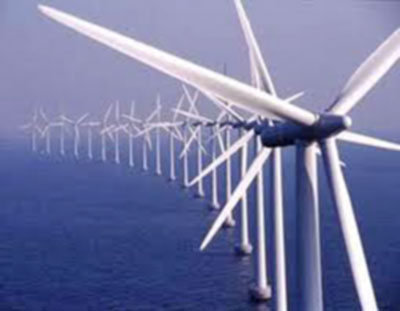
The Celebrity Net Worth site estimates
Al Gore’s personal fortune at $100 million. Not all of the money
comes from global warming. Some of it was from his oil and mining
interests. But it is safe to say that between the books and the
documentary, he has made a few million from the theory.
It sure is easy being green - and it’s lucrative. With all the
federal subsidies and tax breaks out there for going green, I wonder
how sensible it is for a company to fight the global warming theory?
GE, BP and now Exxon have seen the light and are going green to get
the green. Indeed. Going green is a good way to reward those who
raise money for one’s presidential campaign.
Billionaire George Kaiser raised
money for President Obama’s 2008 campaign.
Kaiser and his family’s tax-exempt
foundation had a 35 percent stake in
Solyndra, which received federal
aid from
the Obama administration and
a presidential visit in 2010 to tout its success.
“Kaiser’s role has been among the
subjects of a congressional inquiry into Solyndra since the
California company that received a $535 million U.S. loan
guarantee filed for bankruptcy in September,” Bloomberg News
reported.
Solyndra made solar panels in a market
flooded with them. Wind turbines also are a drag on the market.
Minnesotans For Global Warming
reported last week on what happens to some wind turbines when the
subsidies run out. They die.
“The U.S. experience with wind farms
has left over 14,000 wind turbines abandoned and slowly
decaying. In most instances the turbines are just left as
symbols of a dying Climate Religion.
“Nowhere have the Green Environmentalists appeared to clear up
their mess or even complain about the abandoned wind farms,”
Minnesotans For Global Warming reported.
The figure - 14,000 dead wind turbines -
comes from Andrew Walden of the American Thinker in his report on
the demise of a wind farm at Kamaoa, Hawaii.
It was abandoned in 2006 after 21 years
of haphazard operation. Besides killing migratory birds and bats -
leading some smart alecks to call them Cuisinarts - wind turbines
are expensive to operate.
“The ghosts of Kamaoa are not alone
in warning us,” Walden wrote.
“Five other abandoned wind sites dot
the Hawaiian Isles - but it is in California where the impact of
past mandates and subsidies is felt most strongly. Thousands of
abandoned wind turbines littered the landscape of wind energy’s
California big three locations - Altamont Pass, Tehachapi, and
San Gorgonio - considered among the world’s best wind sites.”
Wind isn’t the most important thing
about wind turbines. It is all about the tax subsidies.
The blades churn until the money runs
out. If an honest history is written about the turn of the 21st
century, it will include a large, harsh chapter on how fears
about global warming were overplayed for profit by corporations.
Solyndra is just the iceberg’s tip...
Wind Energy's Ghosts
by Andrew Walden
February 15, 2010
from
AmericanThinker Website
Abandoned Rusted Wind
Turbines Reflect The Hoax Of Environmental
Activists.
Abandoned rusting wind turbines in California,
Hawaii and other locations are the result of
government subsidies that have been discontinued.
Wind energy is just a tax scam.
If wind power made sense, why would it need a
government subsidy in the first place? It's a bubble
which bursts as soon as the government subsidies
end.
It the same scam as the so called stimulus money
Obama uses as a slush fund to buy votes in congress
and prop up state budgets. When the slush fund
stimulus money dries up along with government jobs
Obama will abandon his useful idiots.
His goal of destroying
the US economy will have been completed. Bankrupt
Europe has a lesson for Americans. Obama is a fraud.
Global warming is a fraud. Wind turbines are a scam.
Bankrupt Europe has a lesson for
Congress about wind power.
Wiwo... wiwo... wiwo...
The sound floats on the winds of Ka Le, this southernmost tip of
Hawaii's Big Island, where Polynesian colonists first landed some
1,500 years ago. Some say that Ka Le is haunted - and it is.
But it's haunted not by Hawaii's
legendary
night marchers.
The mysterious sounds are "Na leo o
Kamaoa" - the disembodied voices of 37 skeletal wind turbines
abandoned to rust on the hundred-acre site of the former
Kamaoa Wind Farm.
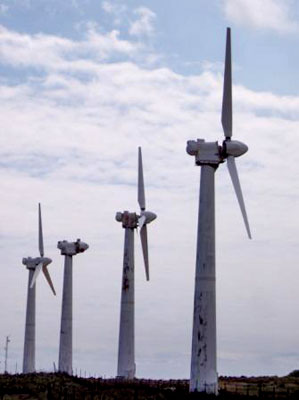
The voices of Kamaoa cry out their
warning as a new batch of colonists, having looted the taxpayers of
Spain, Portugal, and Greece, seeks to expand upon their
multi-billion-dollar foothold half a world away on the shores of the
distant Potomac River.
European wind developers are fleeing the
EU's expiring wind subsidies, shuttering factories, laying off
workers, and leaving billions of Euros of sovereign debt and a
continent-wide financial crisis in their wake.
But their game is not over.
Already they are tapping a new vein of
lucre from the taxpayers and ratepayers of the United States.
The
Waxman-Markey Cap-and-Trade Bill appears to be politically dead
since Republican Scott Brown's paradigm-shattering Massachusetts
Senate victory. But alternative proposals being floated by Senator
Byron Dorgan (D-ND) and others still promise billions of
dollars to wind developers and commit the United States to generate
as much as 20% of its electricity from so-called "renewable"
sources.
The ghosts of Kamaoa are not alone in warning us. Five other
abandoned wind sites dot the Hawaiian Isles - but it is in
California where the impact of past mandates and subsidies is felt
most strongly.
Thousands of abandoned wind turbines
littered the landscape of wind energy's California "big three"
locations,
-
Altamont Pass
-
Tehachapi
-
San Gorgonio,
...considered among the world's best
wind sites.
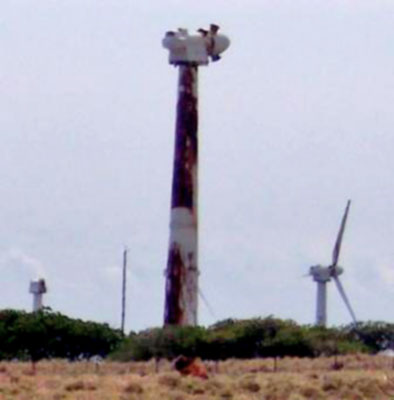
Built in 1985, at the end of the boom,
Kamaoa soon suffered from lack of maintenance. In 1994, the site
lease was purchased by Redwood City, CA-based Apollo Energy.
Cannibalizing parts from the original 37 turbines, Apollo personnel
kept the declining facility going with outdated equipment.
But even
in a place where wind-shaped trees grow sideways, maintenance issues
were overwhelming. By 2004 Kamaoa accounts began to show up on a
Hawaii State Department of Finance
list of unclaimed properties.
In 2006, transmission was finally cut
off by Hawaii Electric Company.
California's wind farms - then comprising about 80% of the world's
wind generation capacity - ceased to generate much more quickly than
Kamaoa. In the best wind spots on earth, over 14,000 turbines were
simply abandoned. Spinning, post-industrial junk which generates
nothing but bird kills.
The City of Palm Springs was forced to enact an ordinance requiring
their removal from San Gorgonio. But California's Kern County,
encompassing the Tehachapi area, has no such law.
Wind Power advocate Paul Gipe,
who got his start as an
early 1970s environmental activist
at Indiana's Ball State University, describes a 1998 Tehachapi tour
thusly:
"Our bus drove directly through the
Tehachapi Gorge passing the abandoned Airtricity site with its
derelict Storm Master and Wind-Matic turbines and the deserted
Wind Source site with its defunct Aeroman machines.
We also got a freeway-close glimpse
of Zond's wind wall with its 400 Vestas V15 turbines, the former
Arbutus site on rugged Pajuela Peak where only the Bonus
turbines are still in service, and steep-sided Cameron Ridge
topped with FloWind's few remaining Darrieus turbines before
reaching SeaWest, our first stop.
"As we approached SeaWest from the desert town of Mojave, the
old Micon 108s were spinning merrily, but the Mitsubishis with
their higher start-up speed were just coming to life.
SeaWest
and Fluidyne had done a commendable job of cleaning the
Mitsubishis of their infamous oil leaks for the tour's arrival."
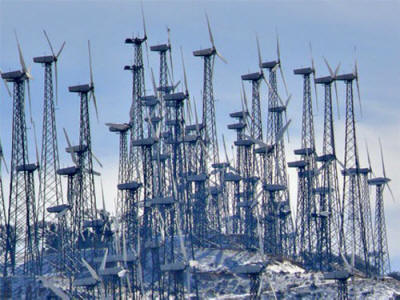
Tehachapi's dead turbines
Writing in the February, 1999
edition of New Energy, Gipe explains:
From 1981 through 1985 federal and
state tax subsidies in California were so great that wealthy
investors could recover up to 50 percent of a wind turbine's
cost. The lure of quick riches resulted in a flood of
development using new and mostly untested wind turbines.
By the end of 1986, when projects
already underway in 1985 were completed, developers had
installed nearly 15,000 wind turbines. These machines
represented 1,200 MW of capacity worth US$2.4 billion in 1986
dollars.
It took nearly a decade from the time
the first flimsy wind turbines were installed before the performance
of California wind projects could dispel the widespread belief among
the public and investors that wind energy was just a tax scam.
Ben Lieberman, a
senior policy analyst focusing on
energy and environmental issues for the Heritage Foundation, is not
surprised.
He asks:
"If wind power made sense, why would
it need a government subsidy in the first place? It's a bubble
which bursts as soon as the government subsidies end."
After the collapse, wind promoters had a
solution to their public image problem. Hide the derelict turbines.
Gipe in 1993 wrote for the
American Wind Energy Association:
Currently most of the older, less
productive wind turbines are located within sight of major
travel corridors such as I-580 and I-10.
Many first generation turbines and
some of the second generation designs are inoperative, and all
turbines of these generations are more prone to mechanical
failure than contemporary designs.
Public opinion surveys have
consistently found that inoperative wind turbines tarnish the
public's perception of wind energy's efficacy."
Gipe then quotes a 1991 UC Davis study,
which explains:
"Our research and that of others
show that turbines' non-operation and public fear of wind farm
abandonment is still a critical issue, and it therefore behooves
the wind industry to return to the 'big three' wind farm sites
(Altamont, San Gorgonio, and Tehachapi) and to ensure that these
areas are operating as efficiently as possible, and all turbine
arrays which do not contribute significantly and conspicuously
to power production are either replaced or, if necessary,
removed."
Altamont's turbines have since 2008 been
tethered four months of every year in an effort to protect migrating
birds after environmentalists filed suit.
According to the
Golden Gate Audubon Society,
...are killed by Altamont turbines
annually.
A
July, 2008 study by the Alameda
County Community Development Agency points to 10,000 annual bird
deaths from Altamont Pass wind turbines.
Audubon calls Altamont,
"probably the worst site ever chosen
for a wind energy project."
In 2004 the group unsuccessfully
challenged renewal applications for 18 of 20 Altamont wind farms.
From its beginnings as a slogan of the anti-nuclear movement, wind
energy has always been tied to taxpayer support and government
intervention. Wind farms got their first boost with the Carter-era
Public Utility Regulatory Policies Act of 1978 (PURPA)
which encouraged states to enact their own tax incentives.
PURPA also for the first time allowed
non-utility energy producers to sell electricity to utilities - the
first step towards a bungled half-privatization of electricity
supply which would come two decades hence.
In the 1985 book "Dynamos
and Virgins" a San Francisco based PG&E utility heir
tells the story of how he joined forces in the 1970s with lawyers
from the Environmental Defense Fund. Together they worked for years
to obstruct coal and nuclear power plants until utilities were
forced to do business with wind energy suppliers.
Protest and litigation remain among the foremost competitive tools
used by the now multi-billion dollar "alternative" energy industry.
Reviewing the book, Robert Reich,
a Kennedy School of Government professor who would later become
Clinton's Secretary of Labor, wrote:
"The old paradigms of large-scale
production, centralized management, and infinite resources are
crumbling. We are on the verge of a new political economy."
The new paradigm created by the
generation of 1968 is more political and less economy.
Without government intervention,
utilities normally avoid wind energy. Wind's erratic power feed
destabilizes power grids and forces engineers to stand by, always
ready to fire up traditional generators. Wind does not fit into an
electric supply model made up of steady massive low cost "base load"
coal or nuclear plants backed up by on-call natural gas powered "peaker"
units which kick in during high demand. No coal or nuclear power
plant has ever been replaced by wind energy.
Although carbon credit schemes often assign profitable carbon
credits to wind farm operators based on a theoretical displacement
of carbon emitted by coal or natural gas producers, in reality these
plants must keep burning to be able to quickly add supply every time
the wind drops off.
The formulae do not take into account
carbon emitted by idling coal and natural gas plants nor the excess
carbon generated by constant fire-up and shut down cycles
necessitated to balance fluctuating wind supplies.
But with PURPA on the federal books, the State of California quickly
created "Interim Standard Offer" (ISO4) contracts guaranteeing a
purchase price based on utilities' "avoided costs" - launching the
first "California Wind Rush".
By 1982 turbines were sprouting from the
dusty terrain of Altamont Pass, Tehachapi, and San Gorgonio. The
ISO4 contracts were written with the assumption that fuel prices
would continue to soar.
But that's not what happened.
By 1985 oil and natural gas prices were dropping. This changed the
"avoided cost" calculations to the disadvantage of alternative
energy producers. ISO4 contracts no longer guaranteed a price
sufficient to attract investment in wind energy.
Construction of new turbines stopped. As
the old ten-year contracts began to expire in the late 1980s,
renewals were pegged at much lower avoided cost estimates. As a
result, many California wind developers quickly closed up shop,
abandoning their turbines to moan out the one note song.
Then Enron got involved...
Building on the foundation laid by PURPA,
1992 Energy Policy Act (EPAct)
began the partial deregulation of wholesale - but not retail -
electricity.
Reich in 1985 had lauded the,
"crumbling" of "large-scale
production (and) centralized management".
He got his wish.
EPAct set the stage for Enron's
California energy market manipulations which led to the 2003 recall
of Governor Gray Davis (D-CA). The movement started by a PG&E
heir led to the bankruptcy of PG&E.
Perhaps this is why some call the
children of the 1960s "the
destructive generation."
Designed to create a renewable energy trading market, EPAct - much
of which took effect in 1997 - created a combination of mandates,
incentives, and tax credits.
These included:
-
Laws requiring large wind
producers to be allowed to tie into the existing utility
grid
-
"Renewable Portfolio Standards"
forcing utilities to buy intermittent wind generated
electricity
-
"Renewable Energy Certificates"
tradable separately from the electricity itself to sell to
companies needing to meet the portfolio standards
-
A 10-year "Production Tax
Credit" that now equals $.019/kWh
-
Accelerated depreciation
allowing tax write-off using an accelerated 5-year
double-declining-balance method (40% per year)
Wind capacity had
stagnated through the mid-1990s.
But Enron in January, 1997
bought out Tehachapi-based industry
leader Zond Corporation - launching the second California Wind Rush.
Four years later, Enron would implode. The company which gamed a
government-crippled artificial marketplace was deconstructed as
poster boy for unbridled capitalism.
But the tax credits, mandates, and regulations which made Enron
possible did not die with it. Enron Wind's turbine manufacturing
subsidiary was purchased by General Electric. Many of its wind farms
went to Florida Light and Power.
By 2009, the US Department of Energy
estimates
mandate-and-subsidy-driven wind capacity would rise to 28,635mw.
That much coal or nuclear "capacity" would power 28.635 million
homes, but wind "capacity" is calculated assuming perfect wind 24
hours a day, 365 days of the year. At the best wind sites, such as
Kamaoa, newly installed turbines generate only 30-40% of "capacity".
At most sites, the figure is 20% or
less. After 30 years of development, wind produces
only 2.3% of California's
electricity.
And then there is maintenance.
The turbines installed in the first wind
rush were not very reliable. Some never worked at all. As the years
passed and the elements took their toll, downtime climbed ever
closer to 100% and production dwindled to negligible amounts.
Developers often set malfunctioning turbines to "virtual" mode -
blades spinning without generating electricity - in order to keep
oil circulating inside the turbine drive.
Of course this habit also gives passing
drivers an illusion of productivity.
Wind developers claim that today's American and European-made
turbines are more reliable and longer-lasting than their old-tech
predecessors. But
new Chinese turbine manufacturers
of untested quality are crowding the marketplace Europe's
subsidy-driven turbine meisters are chased from their home markets.
After the debacle of the First California Wind Rush, the European
Union had moved ahead of the US on efforts to subsidize "renewable"
energy - including a "Feed in Tariff" even more lucrative than the
ISO4 contracts. EU governments provided government-backed securities
to support utilities burdened by Feed-in Tariff costs.
But last year, as the national debt of
wind-intensive EU countries became unbearable, the EU subsidy bubble
burst.
Wind maven Gipe proudly takes a page from the disastrous European
playbook, crediting himself with,
"Almost single-handedly launch(ing)
a campaign for
Advanced Renewable Tariffs
(electricity feed laws) in North America."
But addressing a Heritage Foundation
seminar last May, Dr. Gabriel Calzada, Professor of King Juan
Carlos University in Madrid
explained (below video) what Feed In Tariffs and
other wind subsidies did to Spain (as well as Portugal and Greece)
got into debt:
"The feed-in tariff... would make
(utility) companies go bankrupt eventually. So... the government
guarantees... to give back the money in the future - when (they)
are not going to be in the office any more.
Slowly the market does not want to
have these securities that they are selling. Right now there is
a debt related to these renewable energies that nobody knows how
it is going to be paid - of 16 Billion Euros."
In early 2009 the Socialist government
of Spain reduced alternative energy subsidies by 30%.
Calzada continues:
"At that point the whole pyramid
collapsed. They are firing thousands of people. BP closed down
the two largest solar production plants in Europe. They are
firing between 25,000 and 40,000 people..."
"What do we do with all this industry that we have been creating
with subsidies that now is collapsing? The bubble is too big. We
cannot continue pumping enough money... The President of the
Renewable Industry in Spain (wrote a column arguing that)... the
only way is finding other countries that will give taxpayers'
money away to our industry to take it and continue maintaining
these jobs."
That "other country" is the United
States of America.
Waxman-Markey seems dead, and Europe's southern periphery is
bankrupt.
But the wind-subsidy proposals being
floated in Congress suggest that American political leaders have yet
to understand that "green power" means generating electricity by
burning dollars.
|






